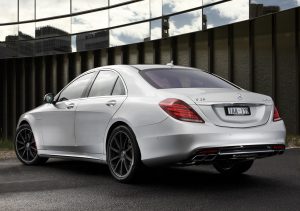Recalls: Mercedes W222/V222 S-Class AMG
Overview
Manufacturers, or importers, issue recalls for defects or faults which have the potential to cause injury. Generally, manufacturers will inform the original buyers if their vehicle is subject to a recall and of the steps required to remedy the defect or fault. Please note that the recalls below (if any) are for Australian-delivered vehicles only. Furthermore, the number of recalls should not be taken as an indication of a model’s reliability or its safety more generally.
Recalls: Mercedes W222/V222 S-Class AMG
Mercedes-AMG 222 S 63: engine may stall
In November 2015, a recall was issued for the Mercedes-AMG S 63 vehicles that were available for sale from 1 November 2014 to 30 September 2015. In these vehicles, software in the engine and transmission control units may cause the engine to stall when the vehicle is coasting to a stop – this may pose a hazard to the vehicle occupants and other road users (PRA 2015/15065).
Mercedes-Benz 222 S-Class: headlights may not have been correctly adjusted
In October 2016, a recall was issued for Mercedes-Benz S-Class vehicles because the headlights may not have been correctly adjusted during production. As such, the headlights may not perform as required and this could increase the risk of a collision (PRA 2016/15702).
2015-16 Mercedes-AMG W222/V222 S-Class: seatbelt handover arm may not retract
In December 2016, a recall was issued for Mercedes-Benz W222 and V222 S-Class vehicles that were available for sale in Australia from 1 November 2015 to 31 March 2016. In these vehicles, incorrect software coding within the rear control unit could result in the seatbelt handover arm not retracting when the vehicle was moving. In the event of a collision, the lack of retraction could impair the correct operation of the front seatbelts and cause the handover arm to break, creating sharp edges (PRA 2016/15792).
2016-17 Mercedes-AMG W222/V222 S-Class: front seatbelt tensioner may not deploy
In October 2017, a recall was issued for Mercedes-AMG W222/V222 S-Class vehicles that were available for sale in Australia from 30 September 2016 to 30 January 2017. In these vehicles, the propellant mixing ratio for passenger seatbelt tensioner squibs may not satisfy design specifications. As a result, the tensioner may not deploy in the event of a collision and this would increase the risk of injury to the passenger. For the VINs of the recalled vehicles, please see PRA 2017/16342.
2016 Mercedes-AMG W222/V222 S-Class: driver’s seatbelt tensioner may not deploy
In October 2017, a recall was issued for Mercedes-AMG W222/V222 S-Class vehicles that were available for sale in Australia from 31 July 2016 to 30 November 2016. In these vehicles, the propellant mixing ratio for the front right (driver) seatbelt tensioner squibs may not meet specifications. As a result, the driver’s seatbelt tensioner may not deploy in the event of a collision and this could increase the risk of injury. For the VINs of the recalled vehicles, please see PRA 2017/16366.
2016-17 Mercedes-AMG W222/V222 S-Class: front seatbelt tensioner squibs
In February 2018, recall campaign RC2443 was issued for Mercedes-AMG W222/V222 S-Class vehicles that were available for sale in Australia from 1 August 2016 to 27 February 2017. In these vehicles, the propellant mix for the front seatbelt tensioner squibs may not have met specifications. The front seatbelt tensioners may therefore not deploy in the event of a collision and this increased the risk of injury to the occupants. For the VINs of the recalled vehicles, please see PRA 2018/16619.
2017-18 Mercedes-AMG W222/V222 S-Class: omission of nuts for mounting busbars in the prefuse box
In September 2018, recall campaign RC2544 was issued for Mercedes-AMG W222/V222 S-Class vehicles that were available for sale in Australia from 1 November 2017 to 28 February 2018. During assembly, two nuts for mounting busbars in the prefuse box located in the vehicle’s trunk may not have been installed – this could increase resistances between the busbars and pose a fire hazard. Furthermore, the interruption of electrical contact of the busbars may lead to function failures. As such, the running of the engine, belt functions and the instrument cluster could be among the components affected – this could increase the risk of a collision and the risk of injury. For the VINs of the recalled vehicles, please see PRA 2018/17060.
2017-18 Mercedes-AMG 222 S 63 Sedan: Active Lane Keeping Assist
In October 2018, recall campaign RC2567 was issued for Mercedes-AMG 222 S 63 Sedans that were available for sale in Australia from 4 November 2017 to 23 February 2018. Camera software could malfunction such that the brakes would not be applied for the Active Lane Keeping Assist function in the case of an inadvertent lane change at speeds over 105 km/h. Steering wheel vibrations, however, would still warn of the lane change. Since the collision prevention function of the Active Lane Keeping Assist system was reduced, the risk of a collision was increased. For the VINs of the recalled vehicles, please see PRA 2018/17093.
2018-19 Mercedes-AMG W222/V222 S-Class: PRE-SAFE may not engage
In March 2019, recall campaigns RC2635 and RC2636 were issued for Mercedes-AMG W222/V222 S-Class vehicles that were available for sale in Australia from 1 August 2018 to 31 January 2019. These vehicles may mistakenly detect a correctly engaged front seatbelt as being not engaged. The driver may be alerted to this condition by a warning tone and a warning symbol in the instrument cluster. Furthermore, the vehicle’s PRE-SAFE function may not engage and this increased the risk of passenger injury in the event of a collision. For the VINs of the recalled vehicles, please see PRA 2019/17405 and PRA 2019/17411.
2019 Mercedes-AMG W222/V222 S-Class: radar sensor control unit failure
In August 2019, recall campaign RC2707 was issued for Mercedes-AMG W222/V222 S-Class vehicles that were available for sale in Australia from 1 March 2019 to 30 July 2019. Due to an error in the active brake assist software, one of the radar sensor control units may fail. If the radar sensor control unit failed, the ‘Active Brake Assist’ function may not activate and this increased the risk of a collision and injury to both vehicle occupants and other road users. To fix, the software for the radar sensor control unit was to be updated. For the VINs of the recalled vehicles, please see PRA 2019/17768.
2018-19 Mercedes-AMG W222/V222 S-Class: oil lines could leak
In March 2020, recall campaign RC2764 was issued for Mercedes-AMG W222/V222 S-Class vehicles that were available for sale in Australia from 1 August 2018 to 30 April 2019. In these vehicles, materials used in the oil lines may not meet the correct specifications – this could result in oil leakages while the vehicle was in operation. If a leak occurred, oil could come into contact with hot components of the vehicle and cause a fire – this posed a risk of serious injury to vehicle occupants and other road users. For the VINs of the recalled vehicles, please see PRA 2020/18261.
2018-20 Mercedes-AMG W222/V222 S-Class: eCall system may not contact emergency services
In December 2021, recall campaign RC2932-RC2933 was issued for 2018-20 Mercedes-AMG W222/V222 S-Class vehicles. Due to a software issue, the automatic network search of the emergency call system (eCall) communication module may be deactivated. If this occurred, the automatic and manual emergency call function may not be available outside of the network coverage of certain providers. If the eCall system was deactivated, it would not be possible for vehicle occupants to contact emergency services in the event of an emergency (either manually or automatically). As a consequence, emergency vehicles may not be directed to the affected vehicle or may be delayed and this could increase the risk of death if a serious injury had occurred. For this recall, no action was required by consumers since the software would be updated ‘over the air’ (i.e. without requiring a workshop visit). For the VINs of the recalled vehicles, please see REC-004979.
2018-20 Mercedes-AMG W222/V222 S-Class: emergency call may not contact emergency services
In April 2022, recall campaign RC2957 was issued for 2018-20 Mercedes-AMG W222/V222 S-Class vehicles. Due to a software issue, the automatic network search of the emergency call system (‘eCall’) communication module may be deactivated. If the eCall system was deactivated, it would not be possible for the vehicle occupants to connect with emergency services, either manually or automatically, in the event of an emergency. As a result, emergency vehicles may not be directed to the affected vehicle or may be delayed; this could increase the risk or severity of injury. For the VINs of the recalled vehicles, please see REC-005401.
Problems and faults: Mercedes W222 S 63 AMG
Overview
This section identifies potential problems, causes and fixes based on the experiences of owners and repairers, online sources and technical service bulletins. This information is provided solely for reference purposes and AustralianCar.Reviews recommends that only properly qualified persons carry out repairs or modifications. Furthermore, the number of items below should not be taken as an indicator of a model’s reliability or the frequency with which they may occur.
To report a problem or fault to the AustralianCar.Reviews team, please use the Contact Us form. Note that AustralianCar.Reviews does not offer advice on automotive problems or disputes; such enquiries will not receive a reply. For vehicles purchased from dealers after 1 January 2011, please see our Australian Consumer Law fact sheet.
Mercedes-Benz W222 S 63 AMG: engine rattle noise after start-up
In December 2015, Mercedes-Benz issued Service Bulletin LI05.10-P-056435 Version 10 for Mercedes-Benz W222 S 63 AMG vehicles that had M157 engines with engine numbers up to 1579xx 60 047752.
According to the Service Bulletin, the driver may hear a rattling noise after start-up – from the engine compartment – that lasts for several seconds. This noise was attributed to a lack of oil pressure in the secondary chain tensioners, though Mercedes-Benz claimed that no consequential damage was to be expected.
To fix, the secondary chain tensioners (left and right) were to be replaced and a check valve was to be installed in the oil supply bore of each secondary chain tensioner in the cylinder head (left and right).




